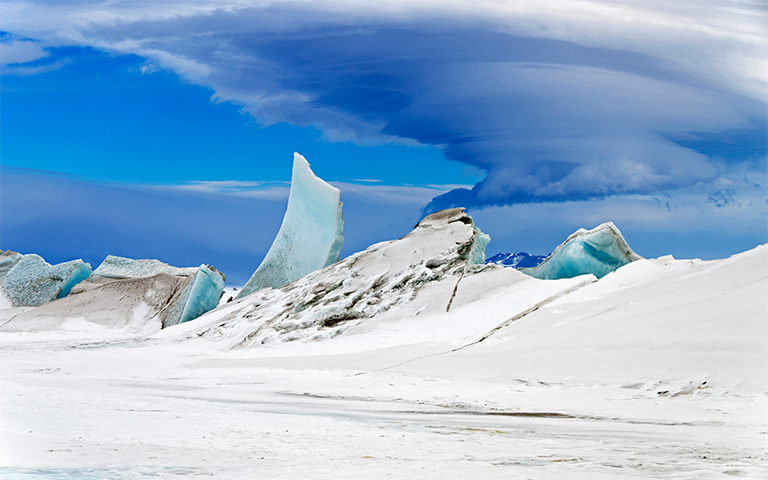Ask NASA Climate | March 9, 2017, 12:08 PST
What's the deal with Antarctica and the Arctic?

This beautiful aerial photograph shows a multi-layered lenticular cloud hovering near Mount Discovery in Antarctica, a volcano about 70 kilometers (44 miles) southwest of McMurdo. Credit: Michael Studinger, Operation IceBridge. Download larger image.
Most people I meet don’t spend much time thinking about the polar regions on planet Earth; the poles just seem too far away. I mean, Antarctica, really? Only extreme explorers and a few scientists spend time thinking about those frozen places. Most of us live in areas with moderate temperatures, fantasize about tropical vacations and have barely checked out what the far reaches of our planet look like on a map. And even maps neglect the far north and south by stretching them so much that many people have no real idea what the ends of the Earth look like.
I became interested, and then obsessed, with Earth’s icy regions during a particularly hot Los Angeles summer a couple of years ago when I created NASA’s Global Ice Viewer. Sitting in my office scouring NASA vaults for the most intriguing views of our planet’s ice was like going on a wild interstellar journey to someplace beyond my wildest imagination; it changed my view of our planet forever.
These days, I frequently give public speeches and show audiences what the Arctic and Antarctic look like from space. It surprises me how little people know about these portions of our world. Perhaps their biggest misunderstanding is that the Arctic and Antarctic are similar. You know, one’s in the north and the other is in the south; but other than that, they’re the same, right? No, this couldn’t be more wrong. These polar opposites are literally polar opposites.
For starters, the Arctic is an ocean surrounded by land: Eurasia, Greenland, Canada and the United States. It’s only about 5.5 million square miles, which is five times smaller than the Atlantic and 11 times smaller than the Pacific. Antarctica, on the other hand, is a continent surrounded by the entire Southern Ocean.
In the winter, the Southern Ocean around the Antarctic continent also becomes covered with sea ice. But every summer most of this sea ice melts. That’s because the ice edge around Antarctica is exposed to open ocean, and every direction you go is north. So, during the summer, most of the sea ice moves north and melts away. This means that very little Antarctic sea ice is more than two years old. But Arctic sea ice is trapped inside the enclosed ocean. This means that during the summer months, even though much of the sea ice melts, it doesn’t melt completely.
More than opposites
Is this complicated enough? If you’ve been reading closely, by now you’ll know that those two types of sea ice are probably super duper different because, yup, you guessed it: The two poles are much more than opposites.
Since 1979, NASA satellite measurements have observed an overall decline in Arctic sea ice due to climate change. Climate change warms the air as well as the ocean water, and melts the sea ice. Climate change has also caused some of the Antarctic ice shelves (which are part of Antarctica’s fresh water ice sheet that extends into the ocean, surrounding the continent) to collapse.
But the story of the sea ice floating around Antarctica in the Southern Ocean is even more complex. This sea ice is not just frozen seawater, like the Arctic sea ice. There’s more snow in the Southern Ocean — that ice is made of sea ice, covered by snow ice (frozen sea water from surface flooding), covered by snow. It’s a snowman ice cream sandwich! And the strong winds down there easily blow this mixture across the ocean surface, making Antarctic sea ice extent highly variable. This year, satellites observed that Antarctic sea ice extent set a record low, dropping to its lowest extent ever recorded.
The fact that our Earth is a crazy complicated place makes it such a challenge to understand, but that same truth also makes it amazing. Earth is never boring, which is why we keep paying attention to and never tire of learning more about it.
Test how much you know and learn more about Earth’s frozen places with these fun quizzes:
As always, I welcome your comments.
Laura
This post is an updated version of a previous blog post.
